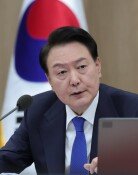`Big gov`t` competition confusing Korean public
`Big gov`t` competition confusing Korean public
Posted November. 10, 2012 05:44,
Government ministries and agencies have been reshuffled more than 50 times since the country`s foundation, but evaluations of the effects of such moves have never been done properly. As state offices are assembled and disassembled according to political interests whenever a new administration takes power, election pledges to create or revamp government agencies are made en masse ahead of every presidential election. The same old practice is recurring this year as candidates are pledging "new politics."
Ruling Saenuri Party presidential candidate Park Geun-hye has pledged to create a Future, Creativity and Science Ministry and an Information, Communication and Telecommunication Ministry. Her main opposition rival Moon Jae-in wants to set up a Job Office. Independent runner Ahn Cheol-soo has urged a Future and Planning Ministry. Thus the three leading contenders are competing to name their versions of new government agencies. Hearing the names alone is not enough to instantly figure out what they will do and how. Were the candidates` pledges to revive the Maritime Affairs and Fisheries Ministry and the Information and Communications Ministry formulated after proper evaluations of the achievements and results of reshuffles? Pledges have also been made to create a string of committees as redundant state bodies placed above ministries, including the Equal Opportunity Committee (Park), the Social and Economic Committee and the National Job Committee (Moon), and the Chaebol Reform Committee and Education Reform Committee (Ahn).
If a new government agency is created, staff for support and management functions, including human resources and general affairs offices, are created and added as well. The expansion of the government`s roles might be inevitable due to the economic crisis, but making election pledges that have not been verified and establishing new government bodies to get votes from interest groups and civil servants will merely pose obstacles to overcoming the crisis rather than help recovery efforts. If the public sector, which is largely inefficient, gets larger, the market will contract and national competiveness will wane. Greece pursued big government and the result was that one-fourth of Greeks became government employees. A large government, which can trigger a fiscal crisis, is not gospel to the people but a disaster.
In the U.S., the lone government agency created over the past 10 years is the Homeland Security Department. Civil servants abroad complain of confusion over which Korean government agency is its foreign counterpart because the names of Korean government agencies frequently change. When the Knowledge Economy Ministry was established following the inauguration of the incumbent administration, foreigners made a flurry of inquires, with one asking, Is it an academic research department? More than a dozen committees whose very existence is questionable are part of the incumbent administration. Also uncomfortable to see is government bodies struggling to secure their own interests ahead of the power transition. The heads of Korea`s two main financial regulators should focus on stabilizing the financial system, but have instead exchanged verbal offensives over the proposed reshuffle of financial regulatory agencies.
If candidates make random election pledges and seek to drum up support by pledging to establish new government agencies, the public will get confused and civil servants cannot focus on their duties. Civil servants whose organizations are moving to Sejong City are expressing concern, with one saying, Will I have to pack my belongings and move again soon? The presidential candidates should present solutions to problems through adjustment of policies and budget distribution before proposing a reshuffle of government bodies. If an organizational reshuffle is necessary, they should draw blueprints after making highly well-prepared pledges and analyzing problems with the existing organizational structure.







